Paradise Lost
Archaeologists in Nova Scotia are uncovering evidence of thriving seventeenth-century French colonists and their brutal expulsion
March/April 2022
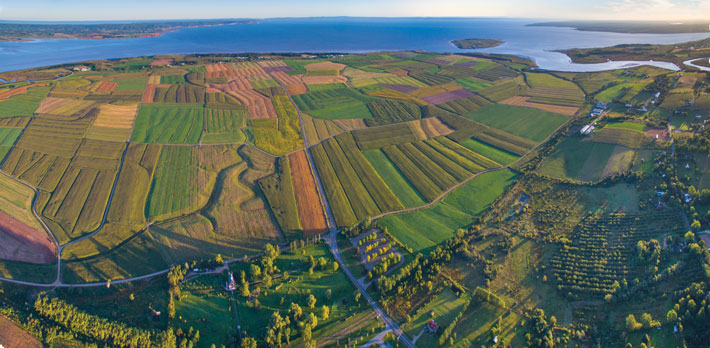 Starting in the early seventeenth century, the French began settling the colony of Acadia—which stretched across what is now Prince Edward Island, Nova Scotia, New Brunswick, and south into Maine—where they established a number of prosperous agricultural communities. A key to their success was a system of dikes they created, particularly in Nova Scotia, that allowed water to drain out of the marshes but prevented seawater from flowing back in. Once rain washed the salt away from this reclaimed land, it became extremely fertile thanks to the rich organic material that had been deposited by the tides over thousands of years. The great quantity of peas, wheat, and other grains, as well as livestock, which the Acadians consumed and exported, helped fuel population growth that is among the fastest ever recorded in human history, up to 4.5 percent per year. Between 1710 and 1730, the Acadian population doubled and then doubled again by 1755, when it reached around 14,000. The Acadians’ ambitious land reclamation project reached its apogee at Grand Pré, or “great meadow,” a village founded by a group of extended families around 1682. Grand Pré overlooked a vast expanse of marshland abutting the Minas Basin, home to the highest tides in the world, which can rise more than 50 feet. The Acadians’ expertise allowed them to tame the tides and transform this salt marsh into robust farmland.
Starting in the early seventeenth century, the French began settling the colony of Acadia—which stretched across what is now Prince Edward Island, Nova Scotia, New Brunswick, and south into Maine—where they established a number of prosperous agricultural communities. A key to their success was a system of dikes they created, particularly in Nova Scotia, that allowed water to drain out of the marshes but prevented seawater from flowing back in. Once rain washed the salt away from this reclaimed land, it became extremely fertile thanks to the rich organic material that had been deposited by the tides over thousands of years. The great quantity of peas, wheat, and other grains, as well as livestock, which the Acadians consumed and exported, helped fuel population growth that is among the fastest ever recorded in human history, up to 4.5 percent per year. Between 1710 and 1730, the Acadian population doubled and then doubled again by 1755, when it reached around 14,000. The Acadians’ ambitious land reclamation project reached its apogee at Grand Pré, or “great meadow,” a village founded by a group of extended families around 1682. Grand Pré overlooked a vast expanse of marshland abutting the Minas Basin, home to the highest tides in the world, which can rise more than 50 feet. The Acadians’ expertise allowed them to tame the tides and transform this salt marsh into robust farmland.
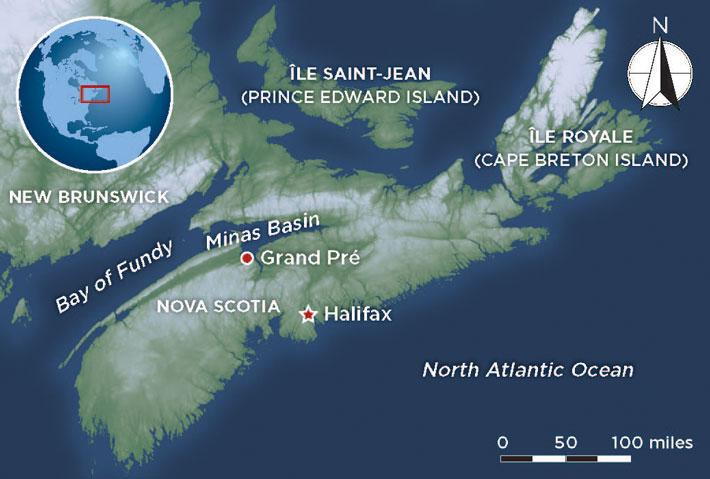 In part because they created their own agricultural land, the Acadians had friendly, collaborative relationships with the Indigenous Mi’kmaq. In a place with such plenty, there was no need to compete for resources. There were even a significant number of marriages between the groups, which was unheard of in the New England colonies to the south, where Native peoples and Europeans were, at best, wary of each other. Heavily influenced by the Mi’kmaq, the Acadians developed a social structure based on communal cooperation that contrasted starkly with the rigid hierarchy they had known in France. This communal spirit was particularly helpful in organizing and carrying out the hard labor necessary to build and maintain the monumental dikes that held back the tides. “In France, if you were a peasant, you were under a nobleman’s control and had no real freedom,” says Rob Ferguson, a retired Parks Canada archaeologist. “When the colonists came to Acadia, they suddenly had control of their own lives. They had their own farms and they could sell their crops. There was intermarrying between levels of society that would never have happened in France. In a way, they really did have a paradise.”
In part because they created their own agricultural land, the Acadians had friendly, collaborative relationships with the Indigenous Mi’kmaq. In a place with such plenty, there was no need to compete for resources. There were even a significant number of marriages between the groups, which was unheard of in the New England colonies to the south, where Native peoples and Europeans were, at best, wary of each other. Heavily influenced by the Mi’kmaq, the Acadians developed a social structure based on communal cooperation that contrasted starkly with the rigid hierarchy they had known in France. This communal spirit was particularly helpful in organizing and carrying out the hard labor necessary to build and maintain the monumental dikes that held back the tides. “In France, if you were a peasant, you were under a nobleman’s control and had no real freedom,” says Rob Ferguson, a retired Parks Canada archaeologist. “When the colonists came to Acadia, they suddenly had control of their own lives. They had their own farms and they could sell their crops. There was intermarrying between levels of society that would never have happened in France. In a way, they really did have a paradise.”
Regardless of their successes, the Acadians were repeatedly caught up in the geopolitical rivalry between France and Britain, with control of Nova Scotia passing back and forth between the two empires multiple times. The Acadians endeavored to remain neutral, resisting attempts by both sides to win their fealty. They cultivated profitable trade relations with New England merchants, whom at least one source records they dubbed nos amis les ennemis, or “our friends the enemy.” Over time, the Acadians came to see themselves as an independent creole people, native to their new land and no longer bound to their home country. They would raise the French or English flag depending on whose gunships were coming to pay a visit. When the British took control of Nova Scotia for good in 1713, the French tried to entice the Acadians to move to Île Royale, modern-day Cape Breton Island, but most remained where they were, reasoning that the British were more likely to leave them alone. They were mistaken, however, and their position grew increasingly precarious. Suspicious of the Acadians because they were Catholic and friendly with the Mi’kmaq, British representatives pressured them to pledge an unconditional oath of allegiance to the Crown. The Acadians managed to fend off their demands for several decades, in no small measure because local British forces depended on their crops for sustenance.
|
Sidebar:
|
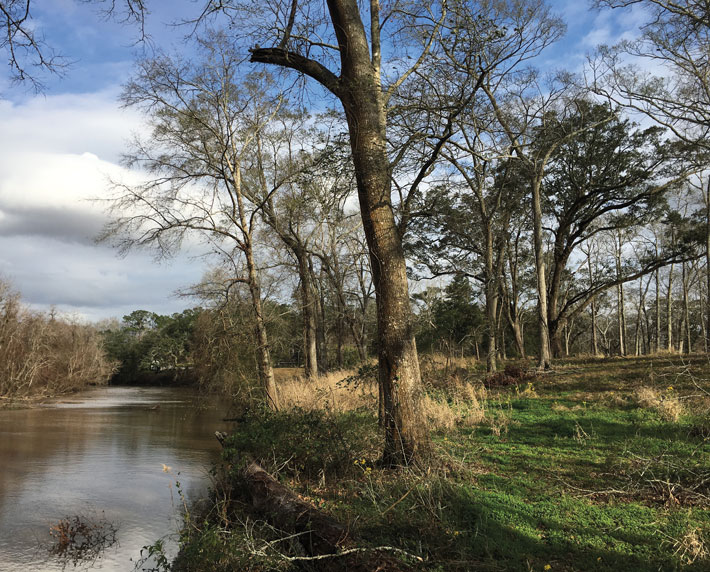
From Acadian to Cajun
|
Also in this Issue:
Advertisement
IN THIS ISSUE
Features
A Monumental Imperial Biography
The Last King of Babylon
Paradise Lost
Exploring Notre Dame's Hidden Past
Letter from Doggerland
Digs & Discoveries
Poetic License
Gone Fishing
A Shining Example
Oliveopolis
Kublai Khan's Sinking Ambitions
The Treasurer's Tomb
Tudor Travelers
Who Drank From Nestor's Cup?
Reflecting the Past
Murder Will Out
Off the Grid
Around the World
Medieval war ponies, an ancient Arabian board game, the Falkland Islands wolf, and the dead of Santorini
Artifact
Connected by craft in the deep past
Advertisement

Recent Issues
-
 May/June 2024
May/June 2024
-
 March/April 2024
March/April 2024
-
 January/February 2024
January/February 2024
-
 November/December 2023
November/December 2023
-
 September/October 2023
September/October 2023
-
 July/August 2023
July/August 2023
-
 May/June 2023
May/June 2023
-
 March/April 2023
March/April 2023
-
 January/February 2023
January/February 2023
-
 November/December 2022
November/December 2022
-
 September/October 2022
September/October 2022
-
 July/August 2022
July/August 2022
-
 May/June 2022
May/June 2022
-
 March/April 2022
March/April 2022
-
 January/February 2022
January/February 2022
-
 November/December 2021
November/December 2021
-
 September/October 2021
September/October 2021
-
 July/August 2021
July/August 2021
-
 May/June 2021
May/June 2021
-
 March/April 2021
March/April 2021
-
 January/February 2021
January/February 2021
-
 November/December 2020
November/December 2020
-
 September/October 2020
September/October 2020
-
 July/August 2020
July/August 2020
-
 May/June 2020
May/June 2020
-
 March/April 2020
March/April 2020
-
 January/February 2020
January/February 2020
-
 November/December 2019
November/December 2019
-
 September/October 2019
September/October 2019
-
 July/August 2019
July/August 2019
-
 May/June 2019
May/June 2019
-
 March/April 2019
March/April 2019
-
 January/February 2019
January/February 2019
-
 November/December 2018
November/December 2018
-
 September/October 2018
September/October 2018
-
 July/August 2018
July/August 2018
-
 May/June 2018
May/June 2018
-
 March/April 2018
March/April 2018
-
 January/February 2018
January/February 2018
-
 November/December 2017
November/December 2017
-
 September/October 2017
September/October 2017
-
 July/August 2017
July/August 2017
-
 May/June 2017
May/June 2017
-
 March/April 2017
March/April 2017
-
 January/February 2017
January/February 2017
-
 November/December 2016
November/December 2016
-
 September/October 2016
September/October 2016
-
 July/August 2016
July/August 2016
-
 May/June 2016
May/June 2016
-
 March/April 2016
March/April 2016
-
 January/February 2016
January/February 2016
-
 November/December 2015
November/December 2015
-
 September/October 2015
September/October 2015
-
 July/August 2015
July/August 2015
-
 May/June 2015
May/June 2015
-
 March/April 2015
March/April 2015
-
 January/February 2015
January/February 2015
-
 November/December 2014
November/December 2014
-
 September/October 2014
September/October 2014
-
 July/August 2014
July/August 2014
-
 May/June 2014
May/June 2014
-
 March/April 2014
March/April 2014
-
 January/February 2014
January/February 2014
-
 November/December 2013
November/December 2013
-
 September/October 2013
September/October 2013
-
 July/August 2013
July/August 2013
-
 May/June 2013
May/June 2013
-
 March/April 2013
March/April 2013
-
 January/February 2013
January/February 2013
-
 November/December 2012
November/December 2012
-
 September/October 2012
September/October 2012
-
 July/August 2012
July/August 2012
-
 May/June 2012
May/June 2012
-
 March/April 2012
March/April 2012
-
 January/February 2012
January/February 2012
-
 November/December 2011
November/December 2011
-
 September/October 2011
September/October 2011
-
 July/August 2011
July/August 2011
-
 May/June 2011
May/June 2011
-
 March/April 2011
March/April 2011
-
 January/February 2011
January/February 2011
Advertisement




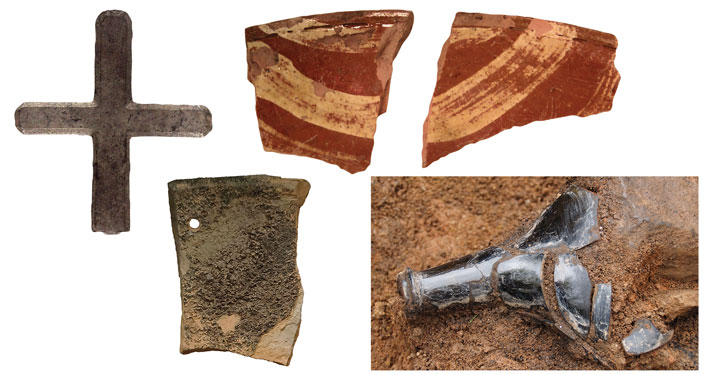 Thus, when Lieutenant-Colonel John Winslow, a British military commander from Massachusetts, arrived at Grand Pré with a detachment of 300 troops on August 19, 1755, many local Acadians assumed this was just the latest attempt to secure their allegiance. When Winslow and his men set up camp in and around the parish church, Saint-Charles-des-Mines, and surrounded it with a defensive palisade, few Acadians panicked. And, on Friday, September 5, when Winslow summoned all men and boys older than 10 living in the village and the surrounding district to meet with him in the church, 418 residents showed up. They were greatly shocked, then, to hear the commander read a proclamation stating that they would have to forfeit their land, livestock, and most other possessions, and that they and their families would be forced to leave their land. Similar messages were delivered to communities elsewhere in Nova Scotia, and over the next few months, more than 6,000 Acadians living there were shipped to destinations throughout the Americas and Europe in overcrowded, inhumane conditions. The remainder fled to the peninsula’s interior to live with the Mi’kmaq, to French-controlled Île Saint-Jean (modern-day Prince Edward Island), or to New Brunswick, which was contested territory at the time. Around 1,000 Acadians perished on the deportation journeys due to shipwreck or disease, and many others were separated from their families. Several thousand more Acadians were expelled from the region over the next few years. (See “
Thus, when Lieutenant-Colonel John Winslow, a British military commander from Massachusetts, arrived at Grand Pré with a detachment of 300 troops on August 19, 1755, many local Acadians assumed this was just the latest attempt to secure their allegiance. When Winslow and his men set up camp in and around the parish church, Saint-Charles-des-Mines, and surrounded it with a defensive palisade, few Acadians panicked. And, on Friday, September 5, when Winslow summoned all men and boys older than 10 living in the village and the surrounding district to meet with him in the church, 418 residents showed up. They were greatly shocked, then, to hear the commander read a proclamation stating that they would have to forfeit their land, livestock, and most other possessions, and that they and their families would be forced to leave their land. Similar messages were delivered to communities elsewhere in Nova Scotia, and over the next few months, more than 6,000 Acadians living there were shipped to destinations throughout the Americas and Europe in overcrowded, inhumane conditions. The remainder fled to the peninsula’s interior to live with the Mi’kmaq, to French-controlled Île Saint-Jean (modern-day Prince Edward Island), or to New Brunswick, which was contested territory at the time. Around 1,000 Acadians perished on the deportation journeys due to shipwreck or disease, and many others were separated from their families. Several thousand more Acadians were expelled from the region over the next few years. (See “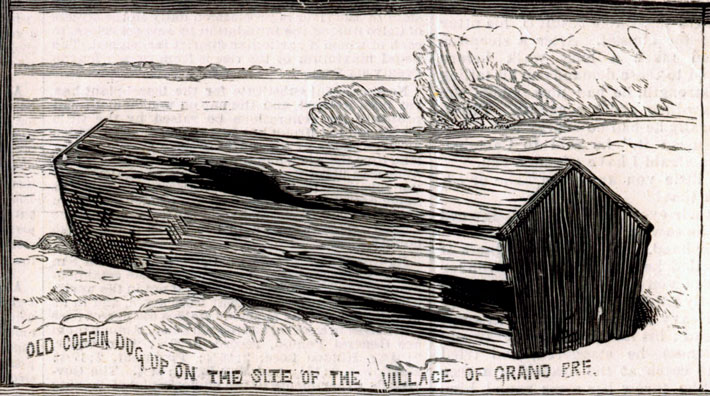 A sense of tragic loss pervaded Acadians’ memories in the decades after 1755, which is reflected in their term for the removal period, le grand dérangement, or “the great upheaval.” Most wounding was the widespread separation of family members. This sentiment was crystallized by Massachusetts poet Henry Wadsworth Longfellow in his wildly popular 1847 epic Evangeline. In it, he portrays the Acadians and their expulsion in highly romantic terms, describing Grand Pré as “the forest primeval,” evoking the “wail of sorrow and anger” that erupts from the men and boys in the parish church when they hear Winslow’s proclamation, and depicting the deportees as “scattered…like flakes of snow” in the driving wind. The poem focuses on a fictional young couple from Grand Pré, Evangeline and Gabriel, who are separated on their wedding day. Evangeline spends the rest of her life trying to track down her beloved only to find him in an almshouse in Philadelphia on the verge of death. They embrace, lamenting the life together that was stolen from them, and he dies in her arms. She follows soon after, and they are buried side by side. “Once Longfellow’s poem became famous, people began visiting sleepy little Grand Pré,” says Fowler. “It was never really well known before, but came to be seen as a kind of holy place in Acadian history.”
A sense of tragic loss pervaded Acadians’ memories in the decades after 1755, which is reflected in their term for the removal period, le grand dérangement, or “the great upheaval.” Most wounding was the widespread separation of family members. This sentiment was crystallized by Massachusetts poet Henry Wadsworth Longfellow in his wildly popular 1847 epic Evangeline. In it, he portrays the Acadians and their expulsion in highly romantic terms, describing Grand Pré as “the forest primeval,” evoking the “wail of sorrow and anger” that erupts from the men and boys in the parish church when they hear Winslow’s proclamation, and depicting the deportees as “scattered…like flakes of snow” in the driving wind. The poem focuses on a fictional young couple from Grand Pré, Evangeline and Gabriel, who are separated on their wedding day. Evangeline spends the rest of her life trying to track down her beloved only to find him in an almshouse in Philadelphia on the verge of death. They embrace, lamenting the life together that was stolen from them, and he dies in her arms. She follows soon after, and they are buried side by side. “Once Longfellow’s poem became famous, people began visiting sleepy little Grand Pré,” says Fowler. “It was never really well known before, but came to be seen as a kind of holy place in Acadian history.”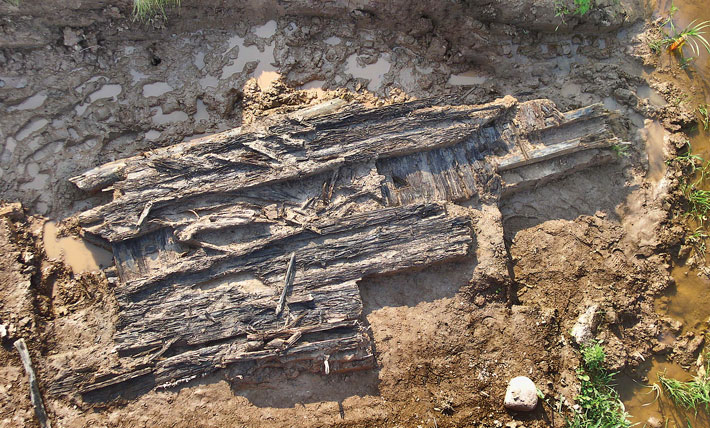 Among those who made the pilgrimage to Grand Pré after Longfellow published Evangeline were amateur antiquarians, who dug up several wooden coffins from the Acadian cemetery near the parish church. One coffin was put on display at a local hotel and another was left at the town’s railroad station, where visitors took it away in parts as souvenirs. In the first decade of the twentieth century, Acadian descendant John Frederic Herbin purchased the land where the cemetery was located and marked it with a stone cross. Then, in the 1920s, a bronze statue of Evangeline was erected and Acadians built a memorial church on the purported site of the 1755 roundup. In 1982, Parks Canada established the Grand-Pré National Historic Site, encompassing the area surrounding the memorial church and Herbin’s Cross. That same year, Parks Canada archaeologists found four grave shafts just north of the cross, confirming that it marks the site of the Acadian cemetery.
Among those who made the pilgrimage to Grand Pré after Longfellow published Evangeline were amateur antiquarians, who dug up several wooden coffins from the Acadian cemetery near the parish church. One coffin was put on display at a local hotel and another was left at the town’s railroad station, where visitors took it away in parts as souvenirs. In the first decade of the twentieth century, Acadian descendant John Frederic Herbin purchased the land where the cemetery was located and marked it with a stone cross. Then, in the 1920s, a bronze statue of Evangeline was erected and Acadians built a memorial church on the purported site of the 1755 roundup. In 1982, Parks Canada established the Grand-Pré National Historic Site, encompassing the area surrounding the memorial church and Herbin’s Cross. That same year, Parks Canada archaeologists found four grave shafts just north of the cross, confirming that it marks the site of the Acadian cemetery.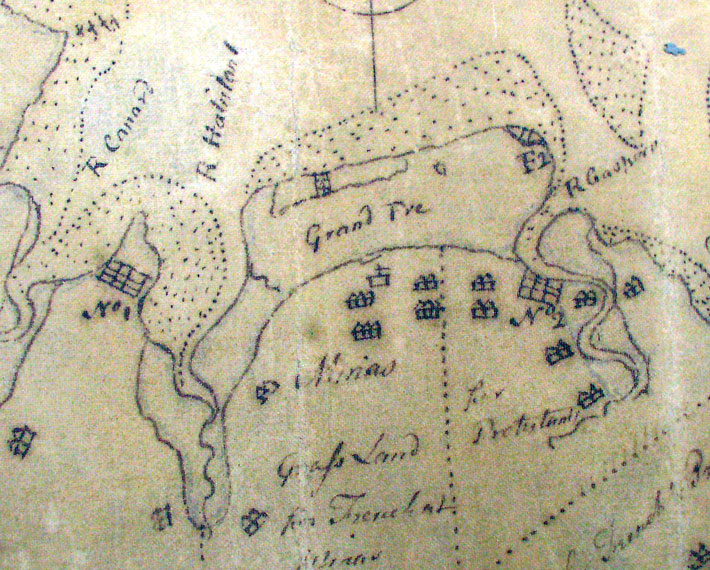 In May 2006, Fowler was called to the Grand Pré marsh, where a machinery operator had unearthed a wooden sluice. This turned out to be an aboiteau, the linchpin of Acadian dikeland agriculture. Essentially a hollowed-out white pine log, it was equipped with a valve that allowed water to drain out of the marsh but blocked seawater from entering as the tide rose. Sod, spruce brush, and wooden stakes were found packed around the aboiteau. The sod was densely matted with marsh grass whose roots grew together to help hold the dikes in place against the onslaught of the tides, while the stakes strengthened the structure, akin to how rebar reinforces concrete. “The preservation of the aboiteau was just stunning,” says Fowler. “You could still see the ax marks, and the spruce boughs and marsh grass were still green. It was a really impressive sight.” The aboiteau was dated to 1691 using dendrochronology, meaning it was put in place within the first decade after Grand Pré was settled. The sluice was found near the middle of the marsh, which is known to be where the Acadians began their land reclamation project. They then worked their way out, diking off the land section by section. By 1755, they had built nearly 19 miles of dike walls to reclaim nearly four square miles of tidal marsh and turned it into a network of highly productive fields.
In May 2006, Fowler was called to the Grand Pré marsh, where a machinery operator had unearthed a wooden sluice. This turned out to be an aboiteau, the linchpin of Acadian dikeland agriculture. Essentially a hollowed-out white pine log, it was equipped with a valve that allowed water to drain out of the marsh but blocked seawater from entering as the tide rose. Sod, spruce brush, and wooden stakes were found packed around the aboiteau. The sod was densely matted with marsh grass whose roots grew together to help hold the dikes in place against the onslaught of the tides, while the stakes strengthened the structure, akin to how rebar reinforces concrete. “The preservation of the aboiteau was just stunning,” says Fowler. “You could still see the ax marks, and the spruce boughs and marsh grass were still green. It was a really impressive sight.” The aboiteau was dated to 1691 using dendrochronology, meaning it was put in place within the first decade after Grand Pré was settled. The sluice was found near the middle of the marsh, which is known to be where the Acadians began their land reclamation project. They then worked their way out, diking off the land section by section. By 1755, they had built nearly 19 miles of dike walls to reclaim nearly four square miles of tidal marsh and turned it into a network of highly productive fields.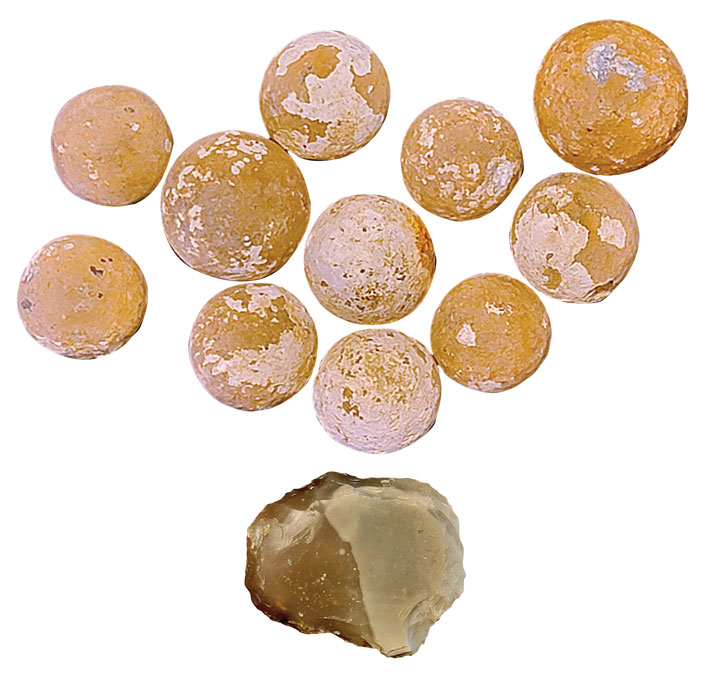 When Parks Canada archaeologists identified grave shafts near Herbin’s Cross in 1982, they unearthed nails and soil stains from the coffins, but the coffins and human skeletons had been eaten away by the site’s acidic soil. Building on this discovery, Fowler has used ground-penetrating radar to map the rest of the Acadian parish cemetery and located 289 graves. On two sides of the cemetery, he has identified thin lines that he interprets as fence lines demarcating its eastern and western edges. In one of these lines, Fowler unearthed carbonized seeds, including oats and peas, traditional staples of the French diet during the period, which he describes as “the fingerprint of the Acadians,” as well as blueberries, which grow wild in the area. “That shows a culture adapting,” Fowler says. “I can imagine the conversations between the European newcomers and the Indigenous inhabitants of the land: ‘Can I eat this, or will it kill me?’”
When Parks Canada archaeologists identified grave shafts near Herbin’s Cross in 1982, they unearthed nails and soil stains from the coffins, but the coffins and human skeletons had been eaten away by the site’s acidic soil. Building on this discovery, Fowler has used ground-penetrating radar to map the rest of the Acadian parish cemetery and located 289 graves. On two sides of the cemetery, he has identified thin lines that he interprets as fence lines demarcating its eastern and western edges. In one of these lines, Fowler unearthed carbonized seeds, including oats and peas, traditional staples of the French diet during the period, which he describes as “the fingerprint of the Acadians,” as well as blueberries, which grow wild in the area. “That shows a culture adapting,” Fowler says. “I can imagine the conversations between the European newcomers and the Indigenous inhabitants of the land: ‘Can I eat this, or will it kill me?’”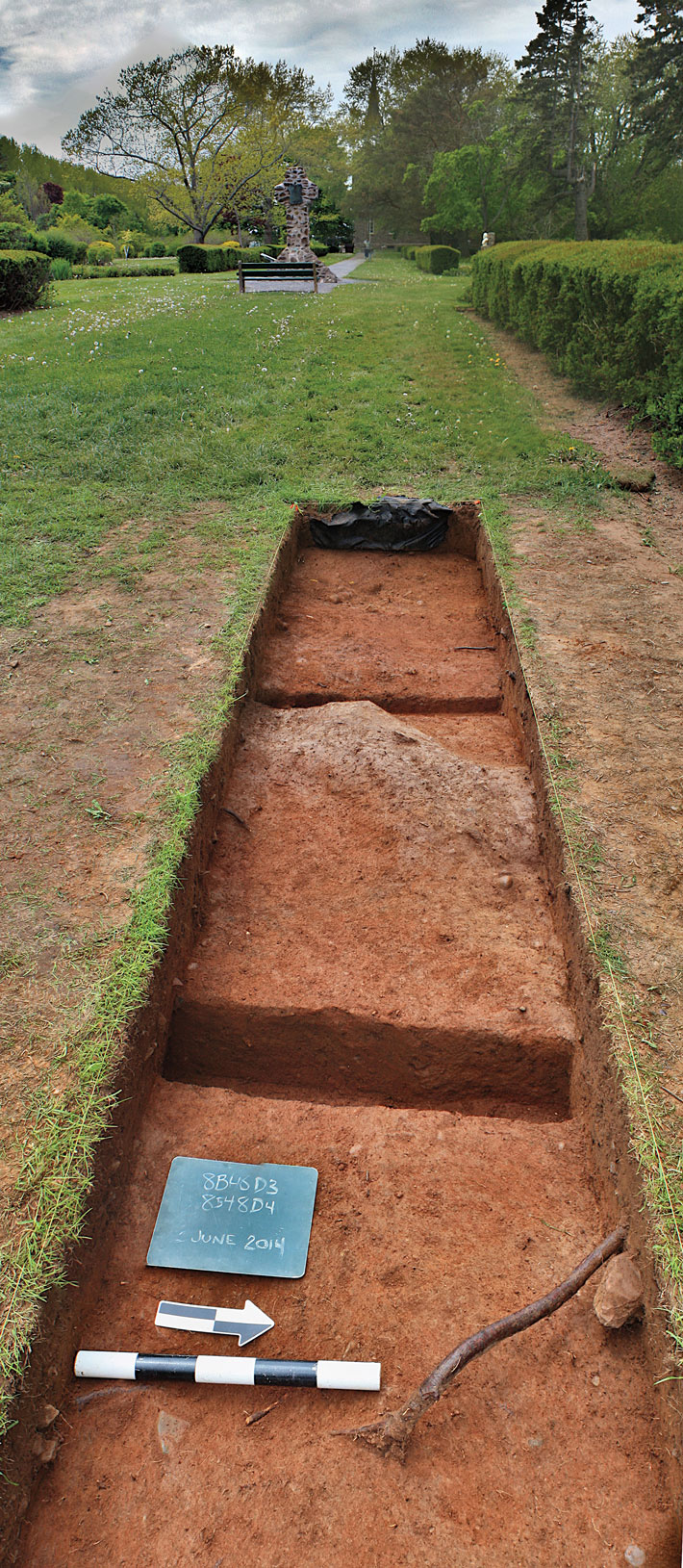 Still, the site of the parish church where Winslow read the deportation order remained elusive. “Our question was, did the people who built the memorial church to mark the spot get it right?” says Fowler. “There had been no professional archaeology done to ascertain whether that was true or not. It was all based on folklore and decisions that were made 100 years ago.” In surveys of Winslow’s camp, Fowler and his team had uncovered the cellars of two Acadian houses, but no foundations large enough to have been the parish church. Then, using magnetic sensing equipment, he detected a burned patch of ground measuring roughly 100 feet by 30 feet. When raised to a high temperature, iron, which is abundant in soil, is magnetized. Fowler’s team carried out excavations of this footprint and determined that a timber building constructed using wattle and daub, which is typical of French colonial architecture, had once stood on the site. Artifacts unearthed below the burn layer date to the French colonial period, whereas those above it date to the late eighteenth century and into modern times, further evidence that the structure was built by the Acadians and then burned at the time of the expulsion or shortly thereafter.
Still, the site of the parish church where Winslow read the deportation order remained elusive. “Our question was, did the people who built the memorial church to mark the spot get it right?” says Fowler. “There had been no professional archaeology done to ascertain whether that was true or not. It was all based on folklore and decisions that were made 100 years ago.” In surveys of Winslow’s camp, Fowler and his team had uncovered the cellars of two Acadian houses, but no foundations large enough to have been the parish church. Then, using magnetic sensing equipment, he detected a burned patch of ground measuring roughly 100 feet by 30 feet. When raised to a high temperature, iron, which is abundant in soil, is magnetized. Fowler’s team carried out excavations of this footprint and determined that a timber building constructed using wattle and daub, which is typical of French colonial architecture, had once stood on the site. Artifacts unearthed below the burn layer date to the French colonial period, whereas those above it date to the late eighteenth century and into modern times, further evidence that the structure was built by the Acadians and then burned at the time of the expulsion or shortly thereafter.

